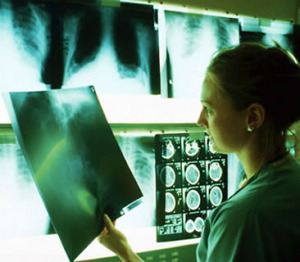Top-down approach reduces radiation exposure
by
Heather Mayer, DOTmed News Reporter | July 06, 2010

Image source: Brigham and
Women's Hospital
Researchers at a New York medical center were able to significantly reduce unnecessary or inappropriate radiographs (X-rays) by implementing a top-down policy, which passed along an imaging algorithm through the departments, according to a study published Thursday in the Journal of the American College of Radiology.
The team of researchers at the University of Rochester Medical Center worked to address the problems of unnecessary or inappropriate X-rays, including unnecessary exposure to radiation, using resources such as rooms and staff, and increasing the cost of medical care, explained lead researcher Mark Adams.
"Cervical spine exams were chosen as a pilot for changing the order behavior of providers in the ER as this was felt to be most straightforward and possibly the easiest to achieve," said Adams, professor and associate chair of the department of imaging sciences.
Adams and his team observed that a large number of X-rays of the cervical spine were ordered even after a computed tomography (CT) scan came back negative.
"If the results of a cervical spine CT are normal, one could make a strong argument that routine radiographs are entirely unnecessary when looking for fracture," he said.
Previous research found that when the imaging sciences department told ordering providers directly not to order a radiograph following negative CT scans, unnecessary tests only decreased by 33 percent from January 2006 to January 2007.
But when this instruction was passed down the chain of command, from the medical director to the departments to the technologists, unnecessary exams decreased by 83 percent between January 2008 and January 2009, according to the report.
"Ordering providers might have seen the new policy as imaging sciences' policy and were more reluctant to accept it," said Adams. "Having the policy dispersed from within their respective departments, there was more of a likelihood for buy-in."
There are plenty of reasons why there is an overuse of radiographs, said Adams, including the way some clinics look at patients, medical liability and staff shortages; sending patients from the emergency room to imaging can save time.
And the negative consequences from over-testing are also plentiful. Not only does it drive up the already expensive cost of health care, overexposure to radiation may also lead to an increased risk of cancer.
"In addition to improving efficiencies, decreasing costs, gains from better resource utilization, there is the added benefit of reduced radiation exposure," said Adams. "Because of the theoretic risk of cancer from exposure to medical radiation, we should always try to minimize medical radiation exposure when possible."
